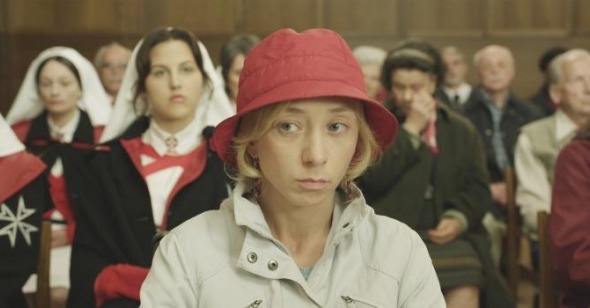Piety Party
by Jeff Reichert
Lourdes
dir. Jessica Hausner, France, Palisades/Tartan
Jessica Hausner’s Lourdes, a starkly designed inquiry into the nature of miracles, exists in a lineage of films that includes Alain Cavalier’s Thérèse, Jacques Rivette’s The Nun, Robert Bresson’s The Trial of Joan of Arc, and professed inspiration, Carl Dreyer’s Ordet. In each, purity of form (often lazily labeled “minimalism” or even more erroneously “transcendentalism”) dovetails with the main character or filmmaker’s intensity of belief. Aesthetically, Lourdes, with its often unadorned and static compositions, fits in with this group nicely. Yet Hausner, for all the honesty of her investigation, and the asceticism of her visuals, approaches the idea of miracles with a detached, quizzical eye.
Her protagonist, Christine, a wheelchair-bound quadriplegic pilgrim to France’s Lourdes shrine (famous for Virgin Mary visitations and miraculous healing), even though often shown alone, seems an afterthought within the frame, so regularly is she viewed from behind, or off to the side. Subtle zooms and compositions that bustle like those of Tati suggest a somewhat askance view of the proceedings, an interest less in miracles themselves than the skepticism and procedural morass that surrounds their certification; flashes of arid humor suggest Hausner might be the type who’d seek out a Virgin Mary toast on auction for fun, or even make one herself.
Hausner takes care to sketch out Christine’s pilgrimage routine over the course of the film’s first third. In these thirty minutes, Lourdes drifts along an ambient route in which divine intervention, though often discussed, seems well nigh impossible, so overwhelmed is the idea by the sheer immensity of mundanity surrounding the shrine. There’s much talk of miracles, but the ritual preparation for being touched by God looks awfully familiar: waking, dressing, meals, idle conversation with strangers, trips to mass. Though glimpses of the exterior architecture of the Lourdes shrine feel grandiose, Hausner’s tight framing of its interiors emphasize its generic qualities. Christine’s pilgrim group might as well be visiting the leaning tower of Pisa, much less one of the most revered sites of spiritual healing in the world.
Midway through Lourdes, Hauser breaks from Christine’s perspective to sit with a small group of members from the Order of Malta (a sovereign Catholic military order formed in 1050 that’s now mostly concerned with caring for the sick and elderly) joking in the hotel lobby. The punch line of a winding setup involving the Virgin Mary and God deciding on where to vacation: Mary thinks Lourdes is a great idea because she’s never been there. Throughout, such wry touches, and the film’s focus on the systems and personages that surround the Lourdes shrine as opposed to the individual experience of the divine, foster a pleasing ambivalence. Pilgrimage group leader, Cecile (Elina Löwensohn) actively believes, but her young attendants are more interested in partying with the Malta Knights in their group. Christine seems among the least pious and least interested in being healed of those on the pilgrimage (she admits to one of her male guardians that she preferred a recent trip to Rome for cultural reasons), yet her roommate, the elderly Madame Hartl (Gilette Barbier), takes it upon herself to ensure Christine has a good place in mass.
One morning, while being wheeled to the shrine yet again by Madame Hartl, Christine reaches out and brushes the sacred wall of the grotto with the back of her hand. She doesn’t seem surprised by this newfound ability, nor does Hausner stop to underscore the moment (Hartl doesn’t notice and wheels her charge out of the frame; Christine’s expression is inscrutable). Soon, Christine is sitting up on her own, then walking with a cane, joining the group on a field trip up into the mountains surrounding the shrine. She quickly becomes a minor celebrity with all the attendant pros and cons: the wait staff at a local restaurant cheers her while she feeds herself a sundae (an ironic mirror of early sequences that focus on her inability to eat without assistance), others eye her jealously and wonder why they weren’t the ones healed. A trip to the International Medical Committee of Lourdes exposes a layer of hard politics surrounding the unexplainable: the office exists to certify the degree of her healing, a first step on the road to the labeling of an actual miracle. (Turns out some reported healings never cross over this elusive benchmark.)
Is Hausner poking fun at the spiritually minded by highlighting the less than divine? Or does Christine’s seeming recovery serve to tweak the skeptics in her audience? It’s an open question that’s left only more ambiguous by the film’s delicious final shot. Lourdes’s deliberately confounding authorial voices leaves Testud as the film’s sole anchor. The actress delivers Christine to us by juxtaposing the rigidity of her frozen posture with the fluid empathy of her eyes; throughout she’s treated as much as an object as a person, unable to move on her own volition yet exuding charms through shy smiles, unexpected jokes. Even when her body becomes freed from the imprisonment of her multiple sclerosis, we’ve become so attuned to watching the flickering play of her facial expressions that her unaided movement through space seems almost an afterthought. Her performance is a small miracle in itself.
